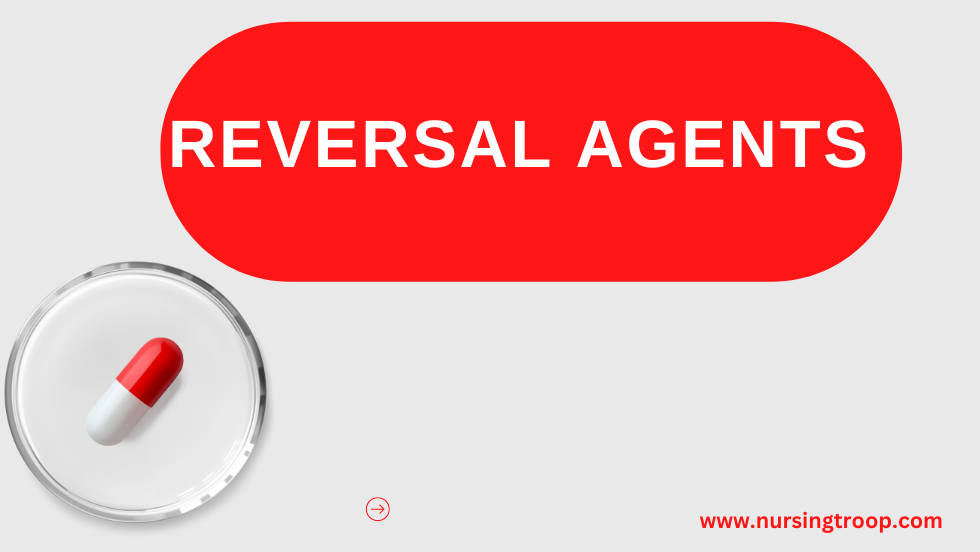Medication reversal agents are substances that counteract the effects of medications or drugs. There are several types of medication reversal agents, including:
- Antidotes
- Chelators
- Enzyme
- Inhibitors
- Receptor Antagonists
Table of Contents
1. Antidotes
Antidotes are substances that directly block or counteract the effects of toxins or drugs. For example, naloxone is an opioid antagonist that reverses the effects of opioids like morphine or heroin. Similarly, flumazenil can reverse the effects of benzodiazepines such as Xanax and Valium.
2. Chelators
Chelators bind to heavy metals and other toxins in the body to prevent their absorption and tissue damage. Examples include deferoxamine for iron poisoning and edetate calcium disodium for lead poisoning.
3. Enzyme
Enzyme inhibitors block enzymes involved in specific metabolic pathways necessary for drug action. For instance, acetylcysteine is an enzyme inhibitor used to treat paracetamol (acetaminophen) overdose by blocking the production of a toxic metabolite known as N-acetyl-p-benzoquinoneimine (NAPQI).
4. Inhibitors
Receptor antagonists interact with cell receptors to reduce drug action at these sites. Examples include antagonists such as naltrexone (for opioid receptors), memantine (for NMDA receptors), propranolol (for β-adrenergic receptors), and ondansetron (for 5HT3 serotonin receptors).
5. Receptor Antagonists
Medication reversal agents can significantly save lives and reduce long-term damage from drug overdoses and toxic exposures when combined with other treatments, such as supportive care. Therefore, individuals need to have access to these substances when needed.
Beyond this, understanding the various medication reversal agents can help healthcare professionals identify the most appropriate treatment for a particular situation.
List of Reversal Agents
| MEDICATION REVERSAL AGENTS
|
|
| MEDICATION
|
REVERSAL AGENT
|
| Acetaminophen | N-acetylcysteine (Mucomyst) |
| Anticholinesterases | Atropine |
| Anticholinergic agents | Physostigmine |
| Anticoagulants | Vitamin K / Protamine |
| Benzodiazepines | Flumazenil (romazicon) |
| Beta-Blockers | Glucagon |
| Calcium channel blockers | Glucagon |
| Cyclophosphamide | Mesna |
| Digoxin, digitoxin | Dexrazoxane |
| Doxorubicin | Digoxin immune Fab (digibind) |
| Fluorouracil | Leucovorin calcium |
| Heparin | Protamine sulphate |
| Iron | Deforoxamine (Desferal) |
| Isoniazid | Pyridoxine |
| Methotrexate | Leucovorin Calcium |
| Opiates | Neloxone (narcan) Nalmefene (revex) |
| Tricyclic antidepressants | Sodium Bicarbonate physictigmine |
| Warfarin | Phytonadione (vitamin K) |
Most Frequently Use Drugs and Their Reverse Agents
Medication: Opioids
Reversal: Naloxone (Narcan)
Naloxone is a medication that has recently become well-known due to the opioid epidemic in the United States. It works by blocking opioids from attaching to receptor sites and thus counteracting their effects. However, naloxone wears off faster than the drug it responds to, so close monitoring of those taking it is necessary for signs of relapse.
Potential side effects: Administered intravenously, intramuscularly, subcutaneously, as a nebulized spray, or as a nasal spray, naloxone may cause agitation, hypertension, and even ventricular tachycardia in doses that are too high.
Thus, knowing the potential side effects when administering the drug is essential.
Medication: Benzodiazepines
Reversal: Flumazenil
Flumazenil reverses the effects of benzodiazepines by blocking their receptors in the brain. It is typically given IV and has a short duration of action, so again, you need to watch for signs of overdose reappearing. It can cause seizures, so you want to avoid it in patients with a history of seizure disorder.
Additionally, it may lead to withdrawal symptoms in chronic benzodiazepine users.
Medication: Barbiturates
Reversal: Sodium thiopental
Sodium thiopental reverses the effects of barbiturates by competing with them for the same receptor sites in the brain. It can cause respiratory depression and hypotension, so you want to be sure you are monitoring your patient closely. Additionally, it has a longer duration of action than barbiturates, so you need to monitor your patient for up to 24 hours after administration.
Medication: Lithium
Reversal: Sodium polystyrene sulfonate
Sodium polystyrene sulfonate reverses the effects of lithium by binding to it in the gut, preventing its absorption. It can cause abdominal pain, vomiting, and diarrhea, so you want to monitor your patient closely. It can also cause hyperkalemia in high doses, so you want to monitor your patient’s potassium levels.
Medication: Anticholinergics
Reversal: Physostigmine
Physostigmine reverses the effects of anticholinergics by blocking their receptors in the brain. It can cause bradycardia, so you want to be sure that you are monitoring your patient’s heart rate closely. It can also cause seizures in high doses, so you want to avoid it in patients with a history of seizure disorder.
Medication: Beta-blockers
Reversal: Glucagon
Glucagon reverses beta-blocker effects by stimulating the production of cyclic AMP, a molecule essential for heart rate regulation. It can cause tachycardia and hypotension, so you must monitor your patient closely. Additionally, it has a short duration of action, so you need to monitor your patient for up to 8 hours after administration.
Medication: Calcium channel blockers
Reversal: High-dose insulin and dextrose
High-dose insulin and dextrose reverse the effects of calcium channel blockers by pushing glucose and potassium into cells, restoring normal cardiac function. It can cause hypoglycemia and electrolyte disturbances, so you want to monitor your patient closely. Additionally, it has a short duration of action, so you need to monitor your patient for up to 8 hours after administration.
Mrs. Marie Brown has been a registered nurse for over 25 years. She began her nursing career at a Level I Trauma Center in downtown Chicago, Illinois. There she worked in the Emergency Department and on the Surgical Intensive Care Unit. After several years, she moved to the Midwest and continued her nursing career in a critical care setting. For the last 10 years of her nursing career, Mrs. Brown worked as a flight nurse with an air ambulance service. During this time, she cared for patients throughout the United States.

